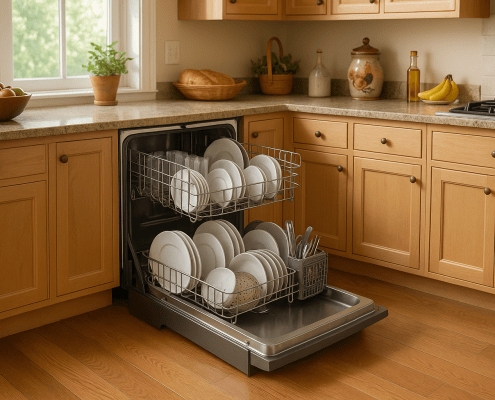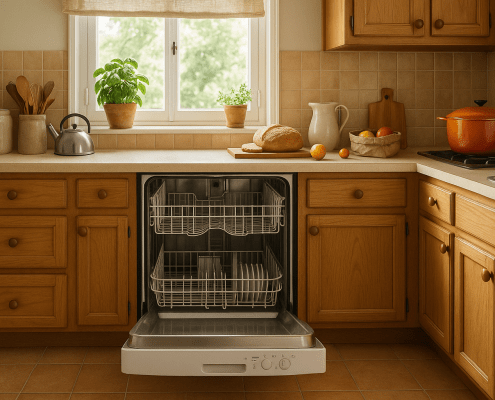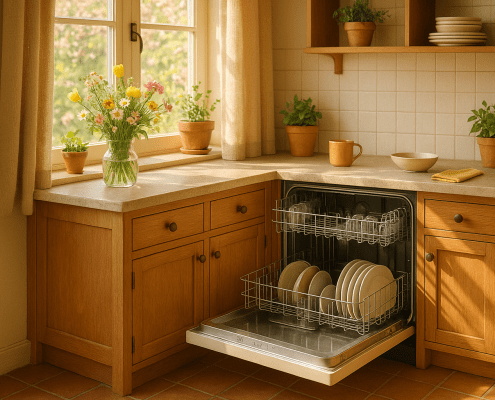How to replace food chopper W10083957V in a Whirlpool, Maytag or KitchenAid dishwasher
Steven E / Thursday January 18, 2024
Is your dishwasher leaving dishes dirty or making odd noises during its cycle? A malfunctioning chopper assembly might be to blame, but don’t worry—you can fix it yourself without calling a pricey technician. Watch our step-by-step video below to learn how to replace the chopper assembly and get your dishwasher running smoothly again!
Your dishwasher’s chopper assembly is responsible for grinding and disposing of food and debris during the cleaning cycle. If your Whirlpool, Maytag or KitchenAid dishwasher isn’t cleaning dishes well or is making unusual noises, a faulty chopper assembly may be the reason.
By replacing it yourself, you can save money on repairs and restore your dishwasher in no time.
If you need a replacement food chopper W10083957V, you can order it here. If you need more replacement parts for your dishwasher, just enter your model number at AppliancePartsPros.com.
Watch: How to replace Whirlpool/KitchenAid/Maytag Chopper W10083957V
What you need
- Pliers
- Flathead screwdriver
- Torx 20 screwdriver
- Torx 10 screwdriver
- 5/8-inch wrench
- Replacement food chopper (use your model number to check for compatibility at AppliancePartsPros.com)
Read more: How Does a Dishwasher Work?
Safety precautions
- Always power off and unplug your appliance or switch off the circuit breaker before attempting any maintenance or replacement work. This keeps you safe by preventing any risk of injury from electric shock.
- Take your time and don’t rush while working to prevent accidents and personal injuries.
- Work in a well-lit area so you can clearly see and access the interior parts.
- Clear your workspace of clutter and other obstacles. Keep children and pets away from the work area.
- Never work on internal parts with bare wet hands. Make sure the work area is completely dry.
- Check your user manual to see if there are specific installation or safety instructions for your part or appliance.
- Be gentle when handling or removing parts. Excessive force might damage the appliance or cause injury.
- Wear insulated work gloves to protect your hands from sharp metal parts, pinching hazards and debris.
- Wear safety glasses when working with chemicals, dust or cleaning large debris to prevent injury.
Read more: How to Clean a Dishwasher
Installation process
- Open the dishwasher door and remove both the upper and lower racks. To remove the upper rack, pull out the rails slightly and locate the release tabs on the backside of the end caps. Use the release tabs to remove the end caps, and then pull out the upper rack and set it aside.
- Use a Phillips screwdriver to remove the screw that holds the plastic tubing to the back wall.
- Grab the big screw on the lower spray arm and turn it clockwise (reverse thread) to release it. Once it’s released, remove the lower spray arm from the dishwasher.
- Turn the water supply tube clockwise to disconnect it. Use a small flathead screwdriver to lift up the locking tab while turning the tube. Once disconnected, continue turning the tube until you can lift it off the pump.
- Use a Torx 20 driver to remove the four screws that secure the chopper assembly in place. Keep track of the screws so you don’t lose them.
- With all the screws removed, lift up the top of the pump to access the chopper assembly.
- Use a Torx 10 driver to remove the screw that holds the plastic assembly in place. Then use a flathead screwdriver to pop the assembly off by releasing the tab.
- Pull the assembly straight up to remove the cover.
- Reach down and pull out the chopper assembly. Disengage it from the motor if necessary.
- Insert the new chopper assembly, and make sure the smaller cutout is on the bottom. To make it easier to push down, place an 11/16-inch wrench between the screen and the metal chopper, positioning the spring-loaded shaft in the short position. Lower the assembly into its slot and remove the wrench.
- Push the cover back down into place and make sure it locks in properly.
- Insert and tighten the screw to secure the cover using a flathead screwdriver or needle-nose pliers. Use a Torx 10 driver to tighten the screw.
- Place the top of the pump housing into position. Make sure it goes all the way down and the tube goes into the bottom of the pump.
- Use a Torx 20 driver to reinstall the screws and secure the pump housing.
- Align the three notches on the water supply tube with the pump body and push down to secure them.
- Lift up on the water supply tube while inserting the other side. Push the notches to the 12 o’clock position and make sure they latch together.
- Position the lower spray arm over the screw part and align the start of the thread with the cutout. Remember that it has a reverse thread, so turn it counterclockwise to tighten. If needed, use pliers to lift the screw part above the cutout before tightening it.
- Use a Phillips screwdriver to reinstall the screw that holds the water supply tube to the back wall.
- Line up the wheels of the upper rack and push it back into the rails.
- Pull the support rails out slightly to install the end caps.
- Slide the end caps down until they lock in place. Repeat the process for the other side.
- Set the lower rack on its track and push it back into place.
- Check that all the racks are properly positioned, then push the dishwasher door to close it.
- Plug the dishwasher back in, turn on the water supply, and restore the power.
- Run a test cycle and check for any unusual noise while it’s working.
Read more: Dishwasher is Noisy: Top 6 Reasons and Fixes
Additional information
Thanks for reading! We hope this article helped you replace the food chopper on your Whirlpool, Maytag or KitchenAid dishwasher.
If you still need some replacement parts, grab your model number and head over to AppliancePartsPros.com. We offer over two million parts and most orders arrive in two business days. If you need some help with finding the right part or placing an order, you can contact our team at 1 (877) 477-7278. We can also help you troubleshoot common dishwasher problems here.
While you’re waiting for your new part to arrive, you can explore our DIY blog and watch thousands of video tutorials on our YouTube channel.
Be sure to follow us on Facebook, Twitter and Instagram to see our latest repair guides!
With nearly a decade of experience in providing top-notch customer service regarding appliance parts and repair, Steven enjoys sharing practical advice, troubleshooting tips, and interesting information to help readers stay informed.





